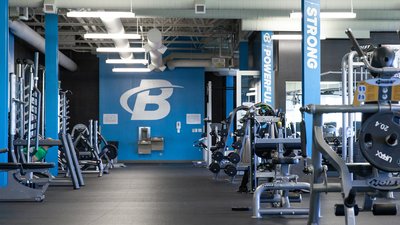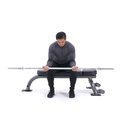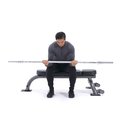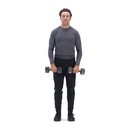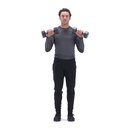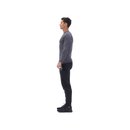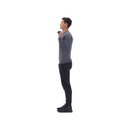Massive forearm development is universally recognized as one of the hallmarks of a complete bodybuilder/strength athlete. Indeed, complete forearm development lends an impression of Herculean power and, functionally speaking, enables an athlete to balance heavier weights as they seek to move greater poundage.
The forearms also enhance grip strength, and thus, assist with pulling exercises. On stage, weak forearm development is readily noticeable and, as a result, detracts from a symmetrical muscular package.
In terms of developing forearms, it is advised that specialized training is to be undertaken if excellent results are desired. However, many are able to forgo any type of specialized forearm training and develop impressive forearms. Impressive forearms are, therefore, oftentimes largely a product of ones genetic potential. Given their stubbornness though, in those with less than favorable genetics, forearms require a tremendous amount of work.
As with calves, it is a case of training them hard and often. It is often thought, that if one handles heavy-weights on a regular basis (particularly during pulling exercises, without wrist-wraps), the forearms should get sufficient stimulation. However, I firmly believe that the forearms require specific exercises.
Given their composition (wrist extensors and wrist flexors, as well as the longer brachioradialis), the forearms are a pretty complex grouping and need to be targeted with exercises which allow for a full contraction.
In my experience, I have found it beneficial to train forearms at the end of biceps training and, on their own (two-days-per-week), before seeing appreciable results. I have also found it of value to target the forearms with a variety of exercises and rep-ranges, to keep them stimulated, and growing.
In this article I will outline exactly why it is important to develop the forearms to their fullest and provide a series of exercises and programs to enhance the forearm growth of anyone regardless of individual genetic limitations.
Why Train The Forearms?
Aesthetic Reasons
Lets be honest. Probably the main reason bodybuilders seek to develop their forearms is to gain a tremendous amount of size in this area, and ultimately improve the overall quality of their physique. Safety considerations and exercise efficiency are unlikely to be factored into the equation when one begins their first set of wrist curls.
Simply put, massive forearm development conveys the impression that one is bewilderingly powerful and can out-lift anyone - they reflect ones physical capabilities. Also, forearms, along with neck, are often the only body-parts seen when a bodybuilder is fully dressed. On stage, complete forearms complete the perfect package of size and symmetry.
Lee Priest is one such bodybuilder with remarkable forearm development, and he is regarded as one of the most massive and symmetrical bodybuilders of all time (he has the much sought after forearm and calve massiveness, along with a small waist).
Safety Reasons, And Grip Strength
By strengthening the forearms, one can enhance their ability to engage in heavy lifting across all muscle groups. Often, the forearms can form a weak link which, in turn, limits the types of exercises one can do. For example, to fully develop the back, chins and bent rowing are fundamental prerequisites. Without a strong grip, using heavy weights with these exercises is next to impossible.
Indeed, increases in forearm strength will lead to upper-body strength gains overall, in that the lifter can safely make the transition to a heavier overall weight increase without fear of the forearms giving out on them mid-set. Thus, in this regard, effective forearm training leads to safer, more efficient, training sessions.
What Are The Best Exercises?
As mentioned, the forearms are comprised of several main muscles: the extensors, flexors and brachioradialis. For maximum results, it is best to train each of these with specific exercises. The following are an exhaustive range of exercises to target all aspects of the forearm complex.
The Wrist Extensors
As their name suggests, the extensors enable the hand to extend backward. The extensors are comprised of eight heads: the extensor digitorum, extensor carpi radialis longus, extensor carpi radialis brevis, extensor carpi ulnaris, extensor indicis, extensor digiti minimi, extensor pollicis longus, and the extensor pollicis brevis. These muscles run the outside length of the forearm and to develop them effectively a number of reverse grip movements need to be employed:
- Barbell Reverse Wrist Curl
- Cable Reverse Curl
- Dumbbell Reverse Curl
One of these exercises can be used for each forearm session. It is worthwhile alternating these movements (as with the following flexor and brachioradialis movements) from workout to workout for varieties sake, and to stimulate further gains. With each movement, turn wrists so palms of hands are facing down, and grip weight, keeping hands in this position.
Rest inner forearms on knees and lower weight to get a full stretch. Then extend wrists to achieve a full contraction. Obviously with dumbbell curls this exercise will need to be completed unilaterally.
The Wrist Flexors
The flexors run the length of the inner forearm and are their most notable muscle in terms of size conveyance. The wrist flexors have six heads: the flexor digitorum superficialis, flexor digitorum profundus, flexor carpi radialis, flexor carpi ulnaris, palmaris longus, and the flexor pollicis longus. To target the wrist flexors employ:
- Barbell Wrist Curls
- Cable Wrist Curls
- Dumbbell Wrist Curls
To execute this movement, grip apparatus as one would prepare for a regular barbell curl. Rest extensors region on upper thigh/knee region with wrists bent forwards as far as possible. Squeeze forearms hard before returning to starting position.
Brachioradialis
The upper/outer portion of the forearm is the brachioradialis. It is the thick cord-like muscle that can be seen when the arm is fully straightened and only has one head (the brachioradialis itself). The brachioradialis can be targeted with:
- Reverse Barbell Curls and Reverse Preacher Curls
- Reverse Cable Curls and Reverse Cable Preacher Curls
- Dumbbell Hammer Curls
Other Ways To Maximize Forearm Size
1. Resist Wrist-strap Use
Wrist-straps will take the stress off the forearms and short-change the trainer in this area. In order to fully stimulate the forearms, they require maximal squeezing.
Straps compensate for a weak grip and it follows that they will negate any form of forearm stimulation, as they prevent optimal squeezing. Those with the strongest grips tend to have the biggest forearms.
2. Use A Thick Bar (or one wrapped with a towel) When Training
This will increase the difficulty associated with gripping the bar and will resultantly contribute to significant increases in forearm size.
3. Use A Wrist-curler
Essentially a wrist-curler is a heavy plate (which can vary in weight) attached to a small bar via a thin rope. To execute this movement, hold arms straight out in front whilst gripping the bar.
Slowly roll bar with one hand at a time until weight has been raised to shoulder height. Then unwind it and repeat, reversing the way in which the bar is rolled (change from working the flexors to the extensors).
Boxing
Repeatedly punching a boxing bag requires a tremendous amount of forearm strength and periodically structuring boxing sessions into ones routine may provide an edge when it comes to developing these muscles to their fullest.
Personally I have found that uppercutting the heavy bag with 50-punches, each arm, works wonders as far as developing the flexors goes.
Programs To Maximize Growth
As with all muscle groups, variation in forearm training can assist in forcing gains in muscle growth. With that in mind, mixing the above exercises around from session to session, rather than keeping with the same routine, should more effectively enhance growth.
When to train forearms is a different story: it is probably best to stick with the same session times each week - preferably at the end of biceps training and on a separate day, possibly with calves.
The following programs can be structured into ones routine at ones discretion (following biceps training and either on their own or with calves tends to work best) - but be sure to mix programs up to avoid boredom and further stimulate gains.

BodyFit
$6.99/month- 2,500+ expert-created single workouts
- 3,500+ how-to exercise videos
- Detailed workout instruction
- Step-by-step workout tips
- Training at gym or at home
- Access to Workout Plans
- Access to Bodyfit App
- Store Discounts
Already have a Bodybuilding.com account with BodyFit? Sign In

What comes with BodyFit?

- Instructional Videos
Don't risk doing a workout improperly! Avoid injury and keep your form in check with in-depth instructional videos.

- How-to Images
View our enormous library of workout photos and see exactly how each exercise should be done before you give it a shot.

- Step-by-Step Instructions
Quickly read through our step-by-step directions to ensure you're doing each workout correctly the first time, every time.

BodyFit
$6.99/month- 2,500+ expert-created single workouts
- 3,500+ how-to exercise videos
- Detailed workout instruction
- Step-by-step workout tips
- Training at gym or at home
- Access to Workout Plans
- Access to Bodyfit App
- Store Discounts
Already have a Bodybuilding.com account with BodyFit? Sign In

What comes with BodyFit?

- Instructional Videos
Don't risk doing a workout improperly! Avoid injury and keep your form in check with in-depth instructional videos.

- How-to Images
View our enormous library of workout photos and see exactly how each exercise should be done before you give it a shot.

- Step-by-Step Instructions
Quickly read through our step-by-step directions to ensure you're doing each workout correctly the first time, every time.

BodyFit
$6.99/month- 2,500+ expert-created single workouts
- 3,500+ how-to exercise videos
- Detailed workout instruction
- Step-by-step workout tips
- Training at gym or at home
- Access to Workout Plans
- Access to Bodyfit App
- Store Discounts
Already have a Bodybuilding.com account with BodyFit? Sign In

What comes with BodyFit?

- Instructional Videos
Don't risk doing a workout improperly! Avoid injury and keep your form in check with in-depth instructional videos.

- How-to Images
View our enormous library of workout photos and see exactly how each exercise should be done before you give it a shot.

- Step-by-Step Instructions
Quickly read through our step-by-step directions to ensure you're doing each workout correctly the first time, every time.
Conclusion
Forearm training might be essential for a number of reasons: to convey an impression of power, promote complete physical development, strengthen the grip, and assist with strength training across all muscle groups.
It is my hope that this article will have served to inspire those who desire physical excellence to attend to this, often neglected, muscle-group.


